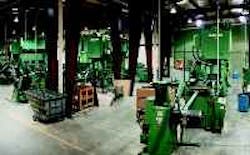A stamping company builds a good foundation for better press production.
Pax Machine Works owns a number of Minster presses. The company recently acquired a milestone machine from Minster — an E2-1000 press, Serial No. 30,000.
According to company President Mike Pax, the company provides a full complement of manufacturing capabilities and supplies Tier 2 automotive suppliers producing suspension and mounting components, safety-restraint devices, and OEM and aftermarket oil-filter parts. "Our niche is in parts requiring high accuracy and repeatability," says Pax. "Our capabilities range from small intricate parts to large, complex progressive-die stampings."
The Pax Lubrication System begins with the press foundation. Once the pit is ready, Pax applies a layer of antivibration material that reduces vibration throughout the pressroom.
The maintenance personnel at Pax fabricate a stainlesssteel-lined pit for holding lubricant. Each tank is custom built to match the Minster press being installed.
The maintenance personnel at Pax also construct an elaborate rebar system for the foundation. They place the stainless-steel liner inside the rebar, which then supports the concrete poured around it.
Pax makes final preparations to the press foundation before pouring the concrete.
The stainlesssteel-lined lube-reclamation pit is ready for the press.
The Paxdesigned Lube System is ready to dispense fluid.
One of the most modern and complete stamping plants in the U.S., Pax Machine Works Inc., Celina, Ohio, is known for integrating systems into its own existing manufacturing framework. One such recent integration involved a new press from The Minster Machine Co., Minster, Ohio. The machine, an E2-1000, features a 168-in. bed, and, because of its size, required a special installation at Pax.
The first step required Pax to cut holes in the ceiling of its facility. After stacking major press components, maintenance personnel completed the press setup by installing four tie rods. They did so by setting up a scaffolding on the roof of Pax's press facility and erecting a temporary roof-top crane with supports resting on top of the press itself. Each of the four tie rods were then lifted up though the holes in the ceiling and lowered into the press.
The press installation also included a special Paxdesigned lubricant system. According to the company, lubricant reclamation begins with the press foundation, so the company mounted the press in a stainless-steel-lined pit incorporated into this foundation. The pit is made so that the top of the press bolster is at a certain height above the floor to ensure consistent setup and easy operator access.
Most of Pax's Minster presses are mounted in this fashion, and it is standard on all new installations. "We use stainless steel to create a sanitary operation, which maximizes the life of the lubricant," says Plant Engineering Manager Bryan Pax. "The stainless steel will not rust, it's stable, and it inhibits bacteria growth."
Once the lubricant is dispensed into the die, it drains through the center of the bed via cutouts in the bolster or special troughs on the outside of the bolster. Both the cutouts and the troughs are custom features added by Minster.
Pax designs its own die doors, which are slanted toward the bed, directing any lubricant toward the bed troughs and, eventually, into the stainless-steel-lined pit below the press. The lubricant drains to the bottom, where it is pumped back into the lube-system reservoir, filtered, and re-used. The lubricant is constantly agitated in the reservoir with air, keeping it well mixed.
Pax also uses special part drainers that tip the basket of parts over to drain lubricant off. This lubricant is also recovered, filtered, and re-used in the process.
The moisture vapor that comes off the parts during the manufacturing process is also recovered using a centrifugal filter. The moist air is drawn from the die space into the filter, where it condenses and flows into the pit below the press. The filter exhausts dry, clean air into the pressroom.
Depending on the press and the application, Bryan Pax says there can be anywhere from 15 to 50 gallons of lubricant being recirculated, of which little is wasted.
"We never intentionally throw lube away," he says. "We periodically check the concentration to maintain the exact lubrication characteristics required to perform the specific job. We maintain the proper concentration by adding the necessary mix to replenish the water and oil lost in the process."
In 1980, Pax began manufacturing its own stock/die lubrication systems. This development led to the creation of Pax Products Inc., which also manufactures in-die conveyors that were originally designed for use in the Pax stamping facility.
Pax Products offers several models of lube systems, the newest of which features an electronic adjustment for both volume and timing. "This allows for maximum versatility," says Bryan Pax. "Each point on the new lube system can be customized to dispense at a predetermined time in whatever volume the user chooses. A PLC on the lube system receives a stroke-position signal from the press.
Depending on the program setup, the lube system reads this signal and dispenses the lubricant in the necessary volume determined by the program."
